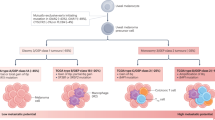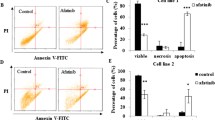Summary
Background Radiotherapy (RT) is the standard treatment for uveal melanoma. However it can cause damage to the retina and optic nerve. This study examined the in vitro and in vivo effects of the anti-VEGF monoclonal antibody bevacizumab associated with radiotherapy (RT) on tumor growth and tumor proliferation and vasculature on OCM-1 human uveal melanoma cell line. Methods The anti-proliferative effects of bevacizumab, RT and their combination were tested both in vitro (OCM-1 cells co-cultured with HUVEC cells in Transwell plates) and in vivo (OCM-1 tumor xenografts in nude mice). In addition, treatment effects in vitro on VEGF secretion, as well as treatment effects in vivo on tumor proliferation (Ki67 labelling), tumor vasculature (VEGFR2 labelling) and VEGF tumoral concentration were analyzed. Results Bevacizumab given alone had a significant impact on tumor growth in vivo (and moderate effects in vitro). The bevacizumab-RT combination had additive effects in vitro (tumor cell proliferation) and in vivo (tumor growth), which translated into a significant decrease in Ki67 expression, VEGFR2 labelling and VEGF tumoral content. Conclusions The bevacizumab-RT combination could be a promising clinical option to explore for the management of human uveal melanoma, since it may allow RT dose reduction without loss of antitumor efficacy.




Similar content being viewed by others
References
Gragoudas ES, Goietin M, Verhey L, Munzenreider J, Suit HD, Koehler A (1980) Proton beam irradiation. An alternative to enucleation for intraocular melanomas. Ophtalmology 87:571–581
Desjardins L, Levy C, d’Hermies F, Frau E, Schlienger P, Habrand JL, Mammar H, Schwartz L, Mazal A, Delacroix S, Nauraye C, Ferrand R, Asselain B (1997) Résultats préliminaires de la protonthérapie du mélanome de la choroïde au centre de protonthérapie d’Orsay (CPO): les 464 premiers cas. Cancer Radiother 1:222–226
Courdi A, Caujolle JP, Grange JD, Diallo-Rosier L, Sahel J, Bacin F, Zur C, Gastaud P, Iborra-Brassart N, Hérault J, Chauvel P (1999) Results of proton therapy of uveal melanomas treated in Nice. Int J Radiat Oncol Biol Phys 45:5–11
Char DH, Quivey JM, Castro JR, Kroll PT (1993) Helium ions versus iodine 125 brachytherapy in the management of uveal melanoma. A prospective, randomized, dynamically balanced trial. Ophtalmology 100:1547–1554
Egan KM, Gragoudas ES, Seddon JM, Glynn RJ, Munzenreider JE, Goitein M, Verhey L, Urie M, Koehler A (1989) The risk of enucleation after proton beam irradiation of uveal melanoma. Ophtalmology 96:1377–1382
Egan KM, Ryan LM, Gragoudas ES (1998) Survival implications of enucleation after definitive radiotherapy for choroïdal melanoma: an example of regression on time-dependent covariates. Arch Ophthalmol 116:366–370
Sheidow TG, Hooper PL, Crukley C, Young J, Heathcote JG (2000) Expression of vascular endothelial growth factor in uveal melanoma and its correlation with metastasis. Br J Ophtalmol 84:750–756
Boyd SR, Tan D, Bunce C, Gittos A, Neale MH, Hungerford JL, Charnock-Jones S, Cree IA (2002) Vascular endothelial growth factor is elevated in ocular fluids of eyes harbouring uveal melanoma: identification of a potential therapeutic window. Br J Ophtalmol 86:448–452
Missotten GS, Notting IC, Schlingemann RO, Zijlmans HJ, Lau C, Eilers PH, Keunen JE, Jager MJ (2006) Vascular endothelial growth factor in eyes with uveal melanoma. Arch Ophtalmol 124:1428–1434
Rosenblatt MI, Azar DT (2006) Antiangiogenic therapy: prospects for treatment of ocular tumors. Semin Ophthalmol 21:151–160
Triozzi PL, Eng C, Singh AD (2008) Targeted therapy for uveal melanoma. Cancer Treat Rev 34:247–258
Spagnolo F, Caltabiano G, Queirolo P (2012) Uveal melanoma. Cancer Treat Rev (in press)
O’Reilly M (2006) Radiation combined with antiangiogenic and antivascular agents. Semin Radiat Oncol 16:45–50
Kan-Mitchell J, Mitchell MS, Rao N, Ligett PE (1989) Characterization of uveal melanoma cell lines that grow as xenografts in rabbit eyes. Invest Ophthalmol Vis Sci 30:829–834
Carmichael J, De Graff W, Gazdar AF, Mumma JO, Mitchell JB (1987) Evaluation of a tetrazolium-based semiautomated colorimetric assay: assessment of chemosensibility testing. Cancer Res 47:936–940
Rich RM, Rosenfeld PJ, Puliafito CA, Dubovy SR, Davis JL, Flynn HW Jr, Gonzalez S, Feuer WJ, Lin RC, Lalwani GA, Nguyen JK, Kumar G (2006) Short-term safety and efficacy of intravitreal bevacizumab (Avastin) for neovascular age-related macular degeneration. Retina 26:495–511
Guérin O, Formento P, Lo Nigro C, Hofman P, Fischel JL, Etienne-Grimaldi MC, Merlano M, Ferrero JM, Milano G (2008) Supra-additive antitumor effect of sunitinib malate (SU11248, Sutent®) combined with docetaxel. A new therapeutic perspective in hormone refractory prostate cancer. J Cancer Res Clin Oncol 134:51–57
Avila MP, Farah ME, Santos A, Duprat JP, Woodward BW, Nau J (2009) Twelve-month short-term safety and visual-acuity results from a multicentre prospective study of epiretinal strontium-90 brachytherapy with bevacizumab for the treatment of subfoveal choroidal neovascularisation secondary to age-related macular degeneration. Br J Ophthalmol 93:305–309
el Filali M, van der Velden PA, Luyten GP, Jager MJ (2012) Anti-angiogenic therapy in uveal melanoma. Dev Ophthalmol 49:117–136
Wachsberger PR, Burd R, Marero N, Daskalakis C, Ryan A, McCue P, Dicker AP (2005) Effect of the tumor vascular-damaging agent, ZD6126, on the radioresponse of U87 glioblastoma. Clin Cancer Res 11:835–842
Nieder C, Wiedenmann N, Andraschke M, Molls N (2006) Current status of angiogenesis inhibitors combined with radiation therapy. Cancer Treat Rev 32:348–364
Finger PT (2008) Radiation retinopathy is treatable with anti-vascular endothelial growth factor bevacizumab (Avastin). Int J Radiat Oncol Biol Phys 70:974–977
Jain RK (2001) Normalizing tumor vasculature with anti-angiogenic therapy: a new paradigm for combination therapy. Nat Med 7:987–989
Dings RP, Loren M, Heun H, McNiel E, Griffioen AW, Mayo KH, Griffin RJ (2007) Scheduling of radiation with angiogenesis inhibitors anginex and Avastin improves therapeutic outcome via vessel normalization. Clin Cancer Res 13:3395–3402
Yang H, Jager MJ, Grossniklaus HE (2010) Bevacizumab suppression of establishment of micrometastases in experimental ocular melanoma. Invest Ophthalmol Vis Sci 51:2835–2842
Lefèvre G, Babchia N, Calipel A, Mouriaux F, Faussat AM, Mrzyk S, Mascarelli F (2009) Activation of the FGF2/FGFR1 autocrine loop for cell proliferation and survival in uveal melanoma cells. Invest Ophthalmol Vis Sci 50:1047–1057
Patel JK, Didolkar MS, Pickren JW, Moore RH (1978) Metastatic pattern of malignant melanoma. A study of 216 autopsy cases. Am J Surg 135:807–810
Adams KS, Abramson DH, Ellsworth RM, Haik BG, Bedford M, Packer S, Seddon J, Albert D, Polivogianis L (1988) Cobalt plaque versus enucleation for uveal melanoma: comparison of survival rates. Br J Ophthalmol 72:494–497
Depotter P, Shields CL, Shields JA, Cater JR, Tardio DJ (1994) Impact of enucleation versus plaque radiotherapy in the management of juxtapapillary choroidal melanoma on patient survival. Br J Ophthalmol 78:109–114
Augsburger JJ, Schneider S, Freire J, Brady LW (1999) Survival following enucleation versus plaque radiotherapy in statistically matched subgroups of patients with choroïdal melanomas: results in patients treated between 1980 and 1987. Graefes Arch Clin Exp Ophthalmol 237:555–559
Conflict of interest
The authors declare that they have no conflict of interest.
Author information
Authors and Affiliations
Corresponding author
Additional information
Results presented in part during the 2009 annual meeting of the American Association for Cancer Research (AACR)
Rights and permissions
About this article
Cite this article
Sudaka, A., Susini, A., Lo Nigro, C. et al. Combination of bevacizumab and irradiation on uveal melanoma: an in vitro and in vivo preclinical study. Invest New Drugs 31, 59–65 (2013). https://doi.org/10.1007/s10637-012-9834-6
Received:
Accepted:
Published:
Issue Date:
DOI: https://doi.org/10.1007/s10637-012-9834-6




